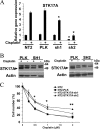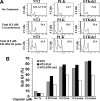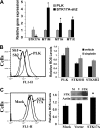Serine/threonine kinase 17A is a novel p53 target gene and modulator of cisplatin toxicity and reactive oxygen species in testicular cancer cells
- PMID: 21489989
- PMCID: PMC3103316
- DOI: 10.1074/jbc.M111.218040
Serine/threonine kinase 17A is a novel p53 target gene and modulator of cisplatin toxicity and reactive oxygen species in testicular cancer cells
Abstract
Testicular cancer is highly curable with cisplatin-based therapy, and testicular cancer-derived human embryonal carcinoma (EC) cells undergo a p53-dominant transcriptional response to cisplatin. In this study, we have discovered that a poorly characterized member of the death-associated protein family of serine/threonine kinases, STK17A (also called DRAK1), is a novel p53 target gene. Cisplatin-mediated induction of STK17A in the EC cell line NT2/D1 was prevented with p53 siRNA. Furthermore, STK17A was induced with cisplatin in HCT116 and MCF10A cells but to a much lesser extent in isogenic p53-suppressed cells. A functional p53 response element that binds endogenous p53 in a cisplatin-dependent manner was identified 5 kb upstream of the first coding exon of STK17A. STK17A is not present in the mouse genome, but the closely related gene STK17B is induced with cisplatin in mouse NIH3T3 cells, although this induction is p53-independent. Interestingly, in human cells containing both STK17A and STK17B, only STK17A is induced with cisplatin. Knockdown of STK17A conferred resistance to cisplatin-induced growth suppression and apoptotic cell death in EC cells. This was associated with the up-regulation of detoxifying and antioxidant genes, including metallothioneins MT1H, MT1M, and MT1X that have previously been implicated in cisplatin resistance. In addition, knockdown of STK17A resulted in decreased cellular reactive oxygen species, whereas STK17A overexpression increased reactive oxygen species. In summary, we have identified STK17A as a novel direct target of p53 and a modulator of cisplatin toxicity and reactive oxygen species in testicular cancer cells.
Figures







Similar articles
-
A p53-dominant transcriptional response to cisplatin in testicular germ cell tumor-derived human embryonal carcinoma.Oncogene. 2005 Sep 8;24(40):6090-100. doi: 10.1038/sj.onc.1208755. Oncogene. 2005. PMID: 15940259
-
Retinoic acid activates p53 in human embryonal carcinoma through retinoid receptor-dependent stimulation of p53 transactivation function.Oncogene. 2001 May 3;20(20):2559-69. doi: 10.1038/sj.onc.1204370. Oncogene. 2001. PMID: 11420666
-
MicroRNA-302a sensitizes testicular embryonal carcinoma cells to cisplatin-induced cell death.J Cell Physiol. 2013 Dec;228(12):2294-304. doi: 10.1002/jcp.24394. J Cell Physiol. 2013. PMID: 23625774
-
Polymorphisms in STK17A gene are associated with systemic lupus erythematosus and its clinical manifestations.Gene. 2013 Sep 25;527(2):435-9. doi: 10.1016/j.gene.2013.06.074. Epub 2013 Jul 13. Gene. 2013. PMID: 23860322 Review.
-
Revisiting DNA damage repair, p53-mediated apoptosis and cisplatin sensitivity in germ cell tumors.Int J Dev Biol. 2013;57(2-4):273-80. doi: 10.1387/ijdb.130135mb. Int J Dev Biol. 2013. PMID: 23784838 Review.
Cited by
-
Potent, Selective, and Orally Bioavailable Quinazoline-Based STK17A/B Dual Inhibitors.ACS Med Chem Lett. 2024 May 20;15(6):945-949. doi: 10.1021/acsmedchemlett.4c00125. eCollection 2024 Jun 13. ACS Med Chem Lett. 2024. PMID: 38894933 Free PMC article.
-
Elucidation of the molecular mechanisms underlying adverse reactions associated with a kinase inhibitor using systems toxicology.NPJ Syst Biol Appl. 2015 Sep 28;1:15005. doi: 10.1038/npjsba.2015.5. eCollection 2015. NPJ Syst Biol Appl. 2015. PMID: 28725458 Free PMC article.
-
RNase L Induces Expression of A Novel Serine/Threonine Protein Kinase, DRAK1, to Promote Apoptosis.Int J Mol Sci. 2019 Jul 19;20(14):3535. doi: 10.3390/ijms20143535. Int J Mol Sci. 2019. PMID: 31330998 Free PMC article.
-
Identification, sequence analysis, and characterization of serine/threonine protein kinase 17A from Clonorchis sinensis.Parasitol Res. 2014 May;113(5):1713-23. doi: 10.1007/s00436-014-3816-x. Epub 2014 Feb 28. Parasitol Res. 2014. PMID: 24578258
-
Degradation of DRAK1 by CUL3/SPOP E3 Ubiquitin ligase promotes tumor growth of paclitaxel-resistant cervical cancer cells.Cell Death Dis. 2022 Feb 22;13(2):169. doi: 10.1038/s41419-022-04619-w. Cell Death Dis. 2022. PMID: 35194034 Free PMC article.
References
-
- Houldsworth J., Korkola J. E., Bosl G. J., Chaganti R. S. (2006) J. Clin. Oncol. 24, 5512–5518 - PubMed
Publication types
MeSH terms
Substances
Grants and funding
LinkOut - more resources
Full Text Sources
Other Literature Sources
Medical
Molecular Biology Databases
Research Materials
Miscellaneous

